Art Fairs
10 of the Best Artworks at Art Basel 2023, From New Provocations by Anne Imhof to a Bravura $22 Million de Kooning
These are the booths that caught the eye of Artnet News's editor-in-chief.
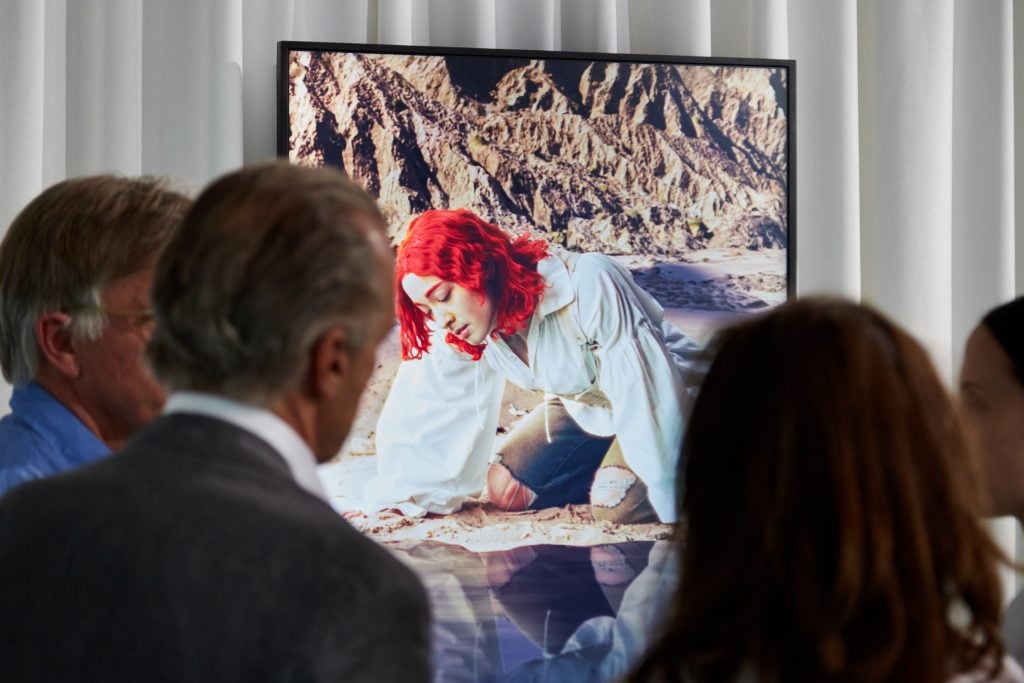
These are the booths that caught the eye of Artnet News's editor-in-chief.

Andrew Goldstein

In the chockablock booths of Art Basel are always mini Ali Baba’s caves, treasures tastefully heaped upon treasures, only with those fineries sometimes taking the form of a poke in the eye or a punch in the gut. This year, however, shocks and innovations are less prominent—the knob has been dialed down to, let’s say, a seven—as galleries tend to their bottom line, serving up comfort food to skittish collectors. There’s plenty to feast on, of course, and you’ll be hard-pressed to find a higher-quality fair this year. Here are some standouts.
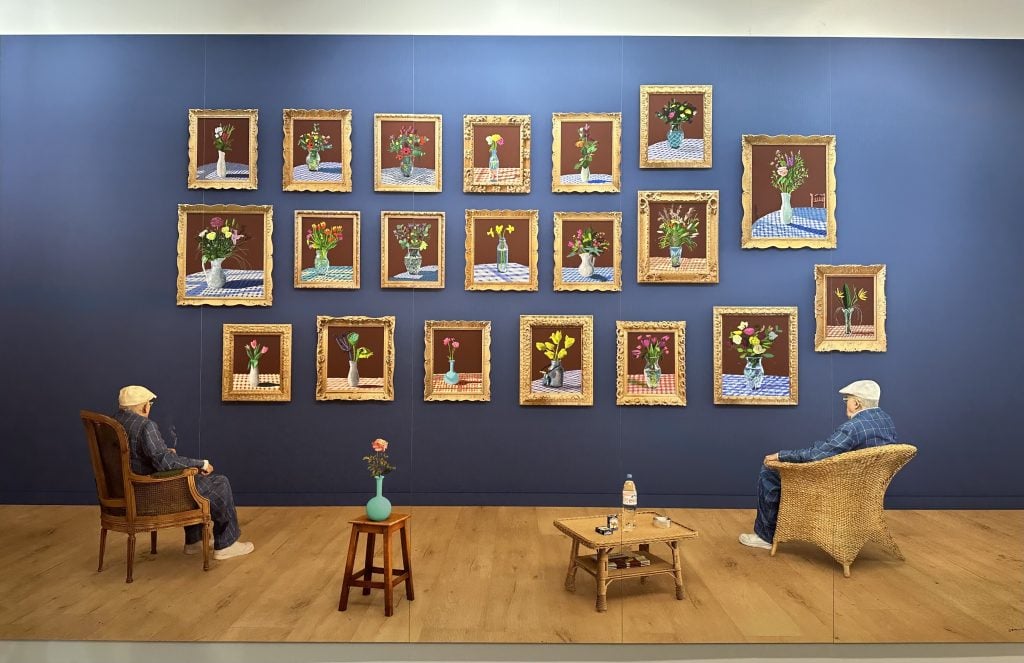
Holed up in his home and studio in Normandy during the global lockdown, David Hockney took refuge in his abiding interests—nature, art history, and, yes, technological innovation—by digitally painting a series of 20 distinctly Matissean floral still-lifes on his iPad. Debuting on the cover of Die Welt in May of 2021 as a verdant symbol of hope after that harrowing winter, the flowers were then exhibited at the Musée Matisse in Nice.
Here, in a sweeping follow-up work made a year later, Hockey presents himself contemplating this series as it hangs on the wall. Rendered as a digital composite of hundreds of snapshots—he terms this approach, a cutting-edge evolution of his longstanding interest in photo collages, a “photographic drawing”—it shows not one but two David Hockneys (one of them smoking his signature Camel cigarettes, packs of which sit on the coffee table above folded copies of his Die Welt issue) as they regard the still-lifes. What is he thinking?
Yet another power move by the seemingly inexhaustible 85-year-old artist, the artwork stretches 17 feet wide across five sheets of paper mounted on Dibond—a colossal size that may give potential buyers pause, despite its bang-for-the-buck price. (It’s from an edition of 15; the price is $350,000.) How much bigger can Hockney go? Just check out his vast immersive installation at London’s Lightroom space, on view through October, where you can be dwarfed and awed by the scale of his artistic ambition.
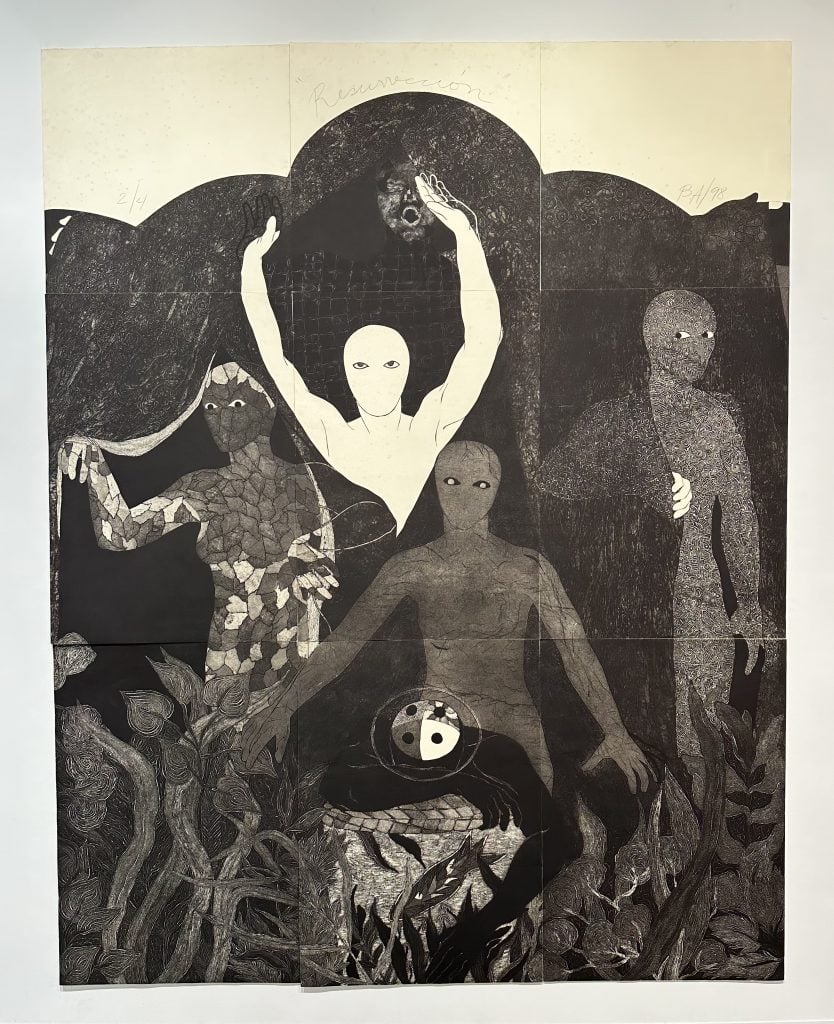
Although she has been touted as a major rediscovery over the past few years as her work has electrified viewers across a string of big-ticket exhibitions, including last year’s Venice Biennale, the Cuban artist and printmaker Belkis Ayón was actually not unknown during her all-too-brief life—in fact, she was enjoying a measure of acclaim by the time of her death, in 1999, at the age of 32. However, it took a herculean effort to keep the flame of her art alive in the wake of her passing—in part because her work, hand-printed with newspaper ink on panels of paper, was so delicate, and in part because its conservation was long left to the care of her family, who were hardly art professionals.
Luckily Ayón’s sister, a doctor in Havana, devoted herself to the artist’s legacy; since the sister’s death, her two children—Ayón’s nieces, both in their 30s—have run the estate with their father. Ten years ago, they also enlisted the help of the Miami dealer David Castillo, who has worked to place her work in the right institutions and private collections. Rarely does Castillo take on inventory—he’s only sold nine pieces over their partnership to date—and the three multi-panel works that he brought to Basel were sold to institutions in advance of the fair—but Ayón’s solo booth has sparked a number of conversations with other interested buyers that the dealer is bringing back to the estate for consideration.
Encountering the work, you understand the demand, and also why the family is so protective. Haunting, unforgettable, and instantly recognizable, the prints are based on the occult teachings that the artist was initiated to when she infiltrated the all-male, Afro-Cuban secret society of Abakuá. In this scene (part of a multi-panel piece priced at $350,000), Princess Sikan, the only female figure in the group’s religion, can be seen, along with the mystical fish whose accidental capture sealed her fate. It’s a long story, but it’s one that museumgoers around the world may soon know. The estate’s objective is to place Ayón’s art in as many major international institutions as possible while her scarce work is still available.
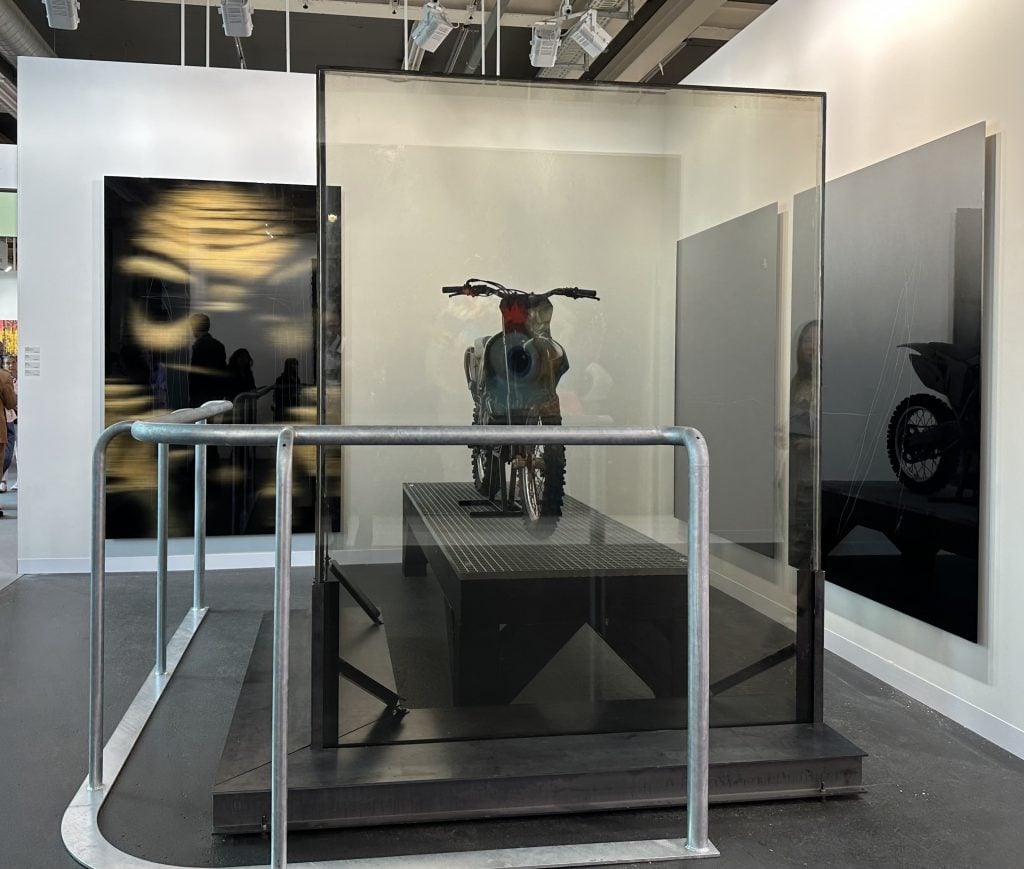
When Anne Imhof, the performance-art phenomenon who rocketed to world fame with her 2017 Golden Lion win, received carte blanche for a 2021 show at the Palais de Tokyo, she seized the opportunity to fulfill a longtime vision to build a labyrinth. She found an abandoned glass-walled building in Rivoli, pulled it apart, brought it to Paris, and reassembled its components in the museum’s basement as a vast industrial stage for a planned performance. Of course, when the world locked down, that performance was impossible. The installation stood vacant for months, while something about sculpture clicked in Imhof’s mind.
Ultimately, the performance took place, with the artist’s devoted troupe of near-feral dancers arriving at the museum on jet-black motorbikes and Jeeps to unleash their ultra-contemporary form of fascist-flirting anarchy. (A video by Imhof in Art Basel’s large-scale Unlimited section captures scenes from the choreographed mayhem.) Then, after the labyrinth was disassembled, the artist did something new: she pulled out components from her set, combining two walls here, a metal stage there, and a dirt bike into sculptural compositions that she calls “rooms”: static but energy-infused expressions of her art that, for the first time, maintain their integrity without the presence of her performers.
According to her gallery, Imhof currently has years of institutional shows lined up, though museums in the United States have lagged behind. Although this installation is bound for a European museum, maybe sculptural installations like this one (tagged €250,000) will prove an easier entry point for curators stateside, paving the way to her inevitable American invasion.
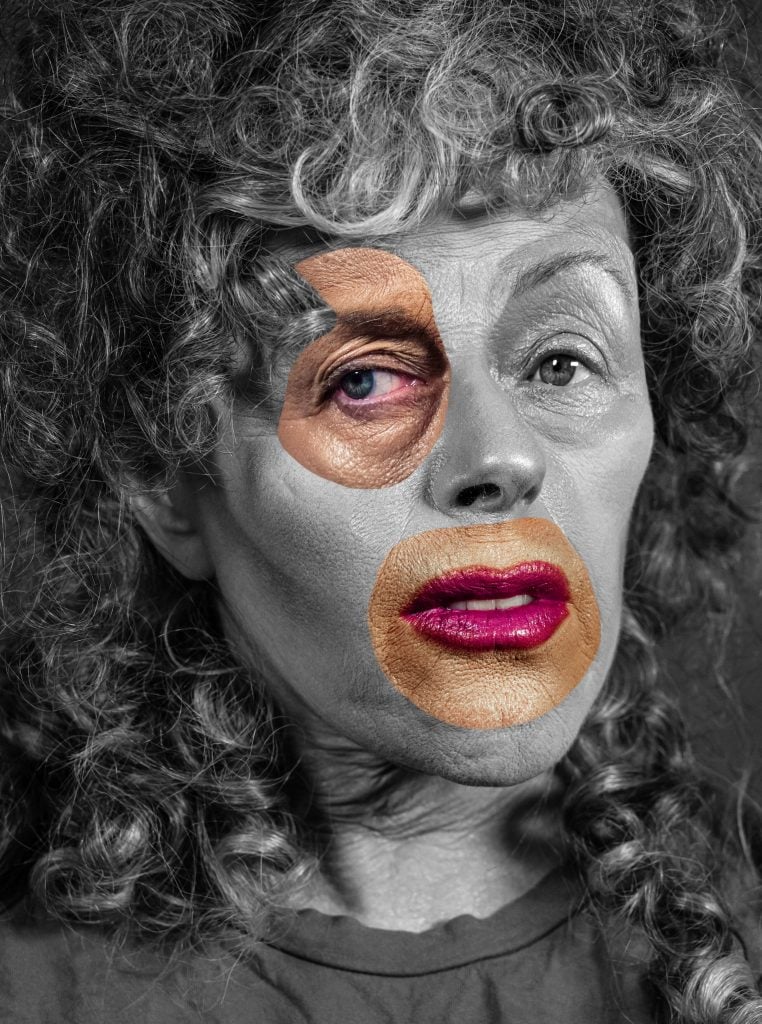
Back in 1975, when Cindy Sherman was studying art at SUNY Buffalo, she made a series of closely cropped black-and-white photos—called Untitled (A, B, C, D, E)—that focused on her face contorted into grotesque characters, an approach that she soon jettisoned in favor of the self-portraits in composed scenes that made her famous. Now, for her first body of new work for Hauser and Wirth, Sherman has revisited this early series to once again place the focus squarely on her face—only this time it is the face of an artist with a career’s worth of staggering innovation, and who is about to turn 70.
Both her age and her bag of tricks are evident in this photo collage, built from a digitally altered self-portrait rendered as a silver gelatin print that has been intercut with lips and an off-kilter eye from a color photo, also digitally altered. Recalling her clown series, her society portraits, and her masks, the work ($200,000) is also an unflinching meditation on growing older by the only artist with so fine-grained an understanding of her own face.
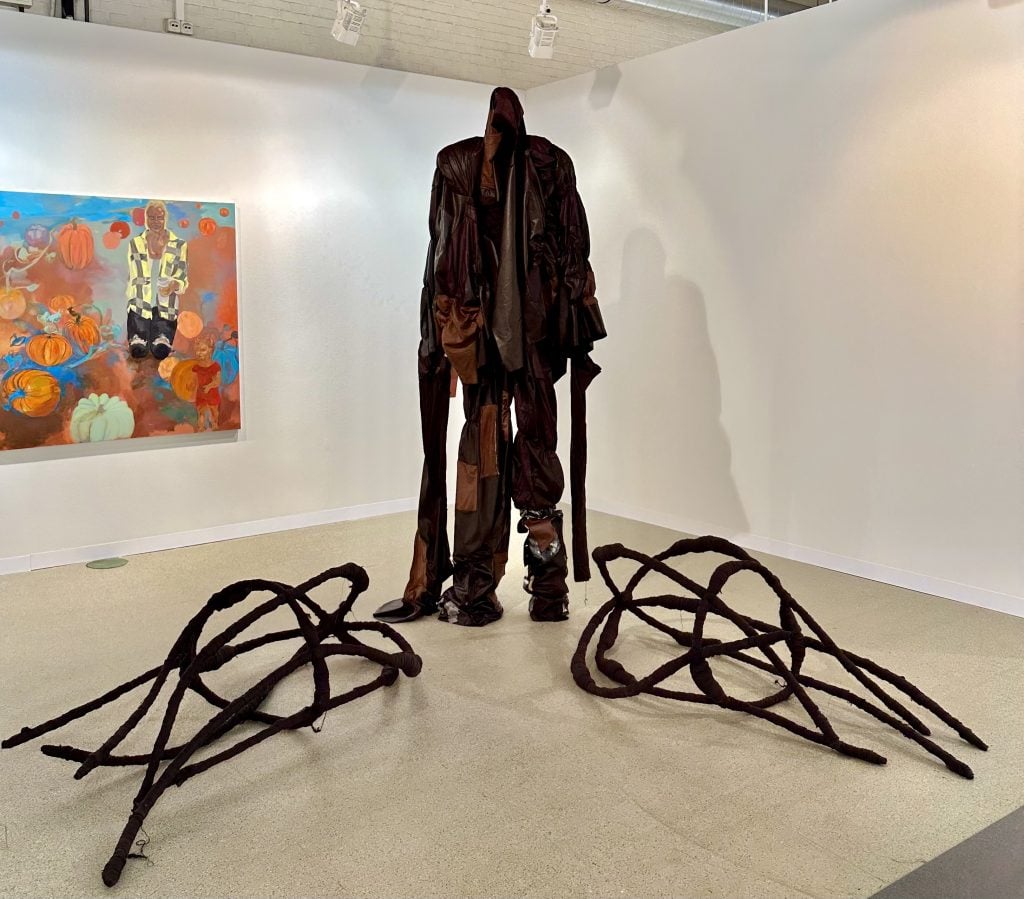
The 34-year-old Congolese-Norwegian artist Sandra Mujinga makes towering, imposing sculptures that seize your attention and burrow into your memory. Built from steel and concrete enshrouded by synthetic leather, her wraithlike figures can be read as specters of colonialism’s atrocities, but the artist also presents them as protagonists in an alternate future—the title of this one (priced at €55,000) refers to the Lingála term for an elder protector figure, imagining it projected into the year 2089—when humans and animals have become alloyed into new hybrids. Her figures are typically shown in groups bathed in a stark computer-green light—as in her bravura showing at the last Venice Biennale—and they are sometimes accompanied by sound or performance or extended into video.
Curators can’t get enough of her work: the winner of German’s 2021 Preis der Nationalgalerie, she was just in a group show at MoMA and will be in another, “Going Dark: The Contemporary Figure at the Edge of Visibility,” coming up at the Guggenheim Museum in New York this December. Encountering the work here, unexpectedly haunting the perimeter of Art Basel’s second floor in the booth of Vienna’s Croy Nielsen gallery, is one of the best moments of the fair.
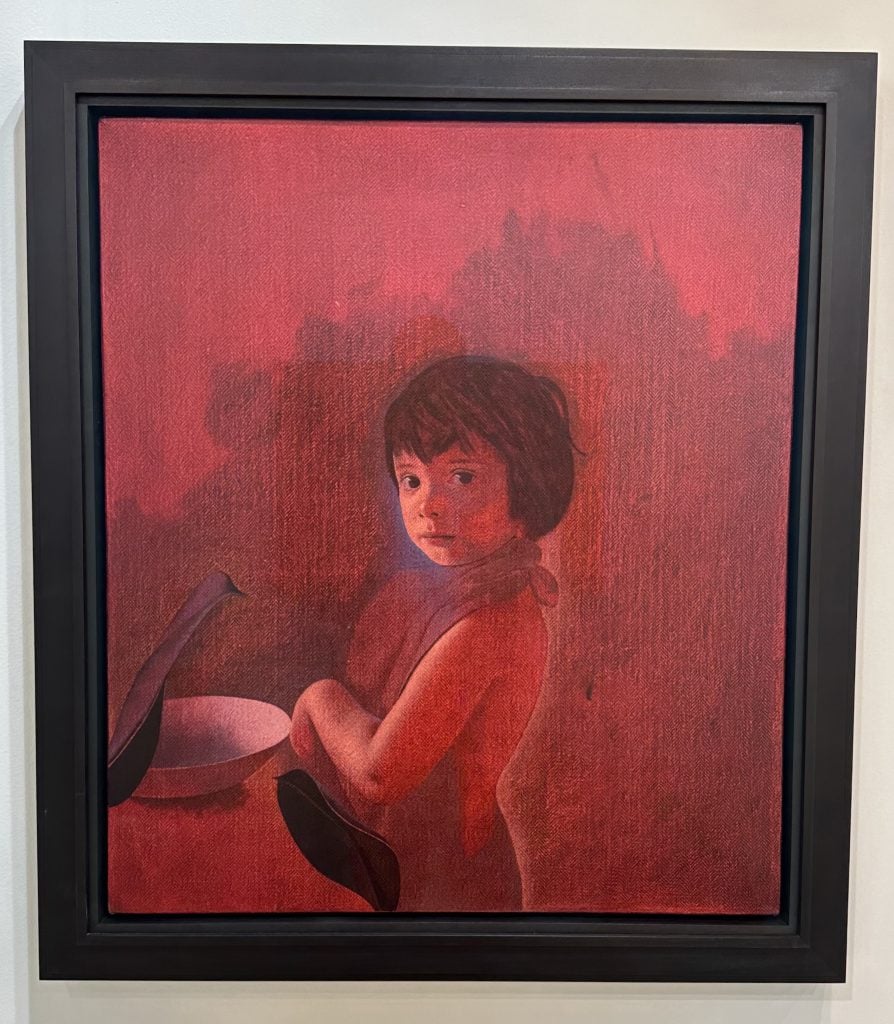
For 10 years, the Scottish-born, Berlin-based artist Oliver Osborne devoted himself to taking photographs of rubber plants, digitally reshaping their composition, and making classically perfect paintings of the result. The purpose? To explore what approaches, what compositions, can make a painting of something ageless—a potted plant—look essentially of its time. In recent years, he has begun incorporating figures from art-historical paintings into these settings. Then, one day, looking at Cézanne’s portrait of his son, his thoughts on timeliness took a twist: what is more eternal yet more in-the-moment than a painting of a child?
This, more or less, is the backstory that yielded up this exquisite portrait Osborne made of his own young son, Alfie, and it will stop you in your tracks. Painted in red on a textured surface of herringbone linen—with two of those rubber-plant leaves lingering around in the foreground—it could be a Chardin or it could be an iPhone snapshot taken at home this morning. This level of portraiture is always relevant; the Berlin-based gallery said it sold in a snap for €25,000, and they could have sold 10 more.
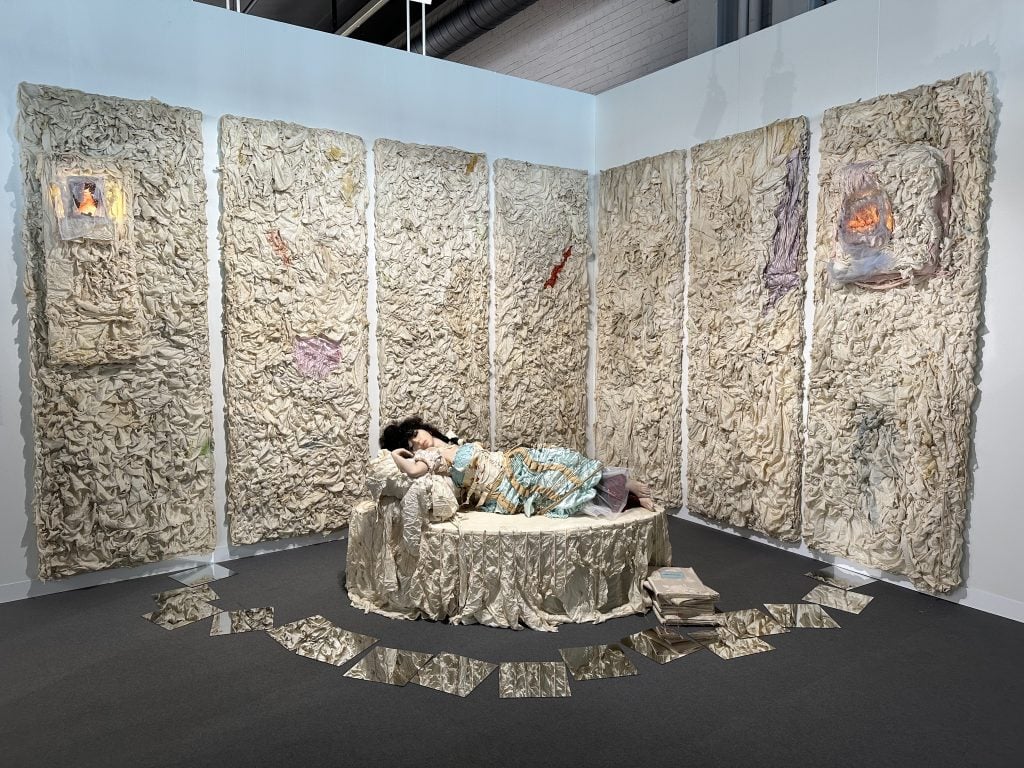
In the 1970s, the Tunisian-born punk-Victorian artist best known as Colette began sleeping in art spaces as a political act, laying down—sometimes naked, sometimes clothed—amid environments of ruched swaths of cream and pink fabric. Endurance performances that sometimes lasted days, these works wrestled with art history by reclaiming the sleeping female body from eons of male painters who have depicted it as a passive object of desire, rendering herself the active, thinking protagonist. They also raised transporting questions about the relationship between art and dreams. When she slept in an Art Basel booth in 1977, in a nook provided by Banco Gallery, was the fair’s greatest masterpiece hanging in the aisles or unfolding in her head?
Now, 46 years later, Colette has fallen back asleep at Basel, though this time in synthetic form, thanks to a collaboration (presented by New York’s Company gallery) with the artist Cajsa von Zeipel, who cast the 71-year-old artist’s face and then remolded it to reflect the younger woman she was half a century ago, placing it atop a cast of a body—a lower-fi version of Harrison Ford’s transformation in The Dial of Destiny (installation priced at $250,000). As for Colette herself? She’s still following her dreams, bound for an artist residency in Paris this fall.

In 1980s New York, the headlines were aflame with the crises roiling the city: the drug epidemic, HIV/AIDS, gangs, street crime. Urgent social problems fused with paranoia, hysteria, and bias, setting in motion chain reactions of mass incarceration, distrust between races, and fear on the streets. The Brooklyn-born photographer Jamel Shabazz looked at the newsstands, where violent crime in the papers mingled with magazine covers of ascendant hip-hop celebrities to provide a starkly binary picture of the world, and asked himself: where were the “real people” he knew from his neighborhood?
He set out to document scenes of ordinary life, joyful fellowship, and laid-back cool among Brooklyn’s Black community, a kind of visual diary. Often taking his portraits after conversations with the subjects, winning their trust, he showed kids being kids, dapper dressers showing off their style, and groups of young men as friends simply hanging out, as in this example brought by Cologne’s Bene Taschen (€5,000–€10,000, depending on size). Meanwhile, to make his living, Shabazz worked for the for the New York City Department of Correction over two decades, including four years on Rikers Island, where he knew the desperate other side of the fence, the guilty and wrongly convicted thrown together in a nightmarish world of violence and despair. When he encountered someone on his portrait-taking rounds in his neighborhood who he worried was on the wrong path, he’d sometimes show them photos he took at Rikers so they could see, too.
It was 25 years before Shabazz began to show his work publicly, but people soon started taking notice, including curators at the Smithsonian and beyond. Now the artist and his photography are having a major moment, with a brand-new show at the Brooklyn Museum—“Jamel Shabazz: Faces and Places, 1980–2023”—following up a career retrospective he received at the Bronx Museum of the Arts last year. Given the headlines we’re starting to see in New York again, amid a spreading atmosphere of tension and fear, the timing could not be better.
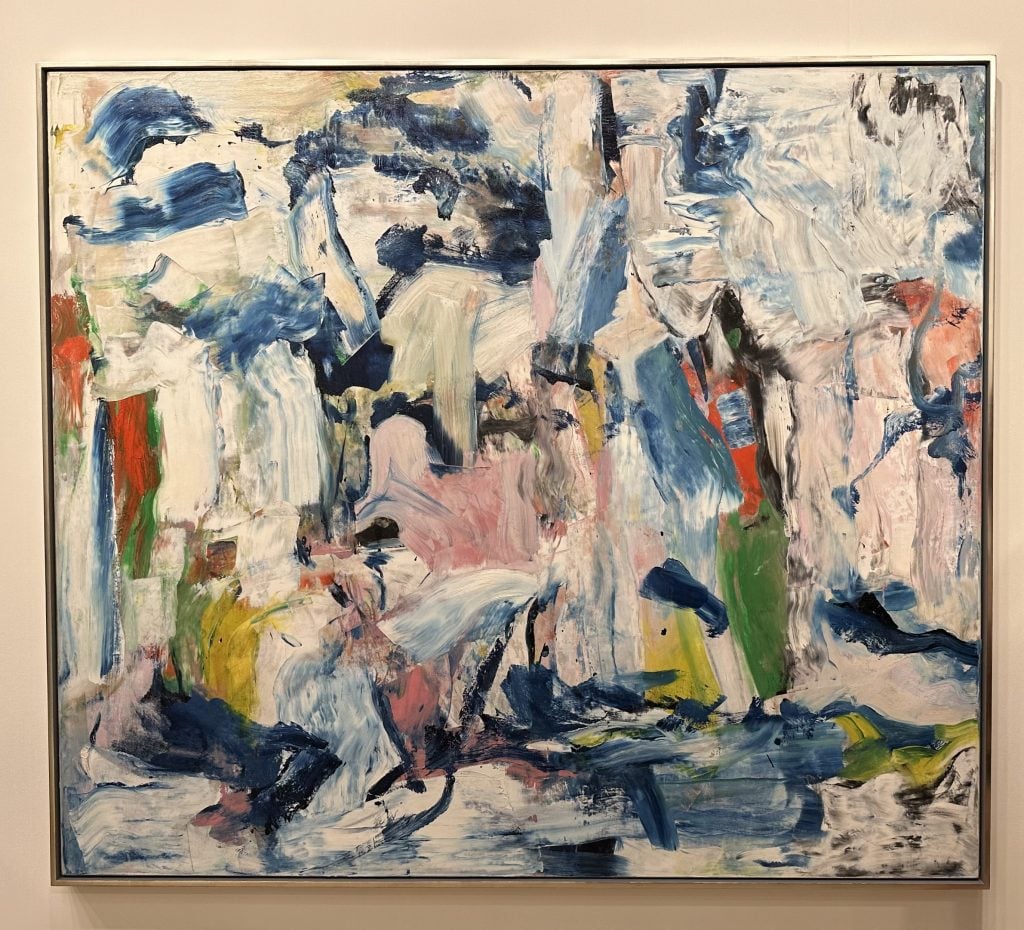
The megawatt booths of Art Basel’s first floor are where great art and great inventory are one and the same, forcing the mind to toggle between parallel stories of art history and the market. For instance, some may recall this de Kooning from Christie’s 20th-century evening sale in New York last November, where it was bought in, but standing in front of the painting (now offered at $22 million) it’s easy to let the dollar signs—even the surrounding fair—melt away and fall back in time to the artist’s studio, in East Hampton, to imagine him at work: In his early 70s, the early part of his late period before his muscular brushstrokes began attenuating into floating ribbons, he’s there with the palette knife, slashing and carving paint colored in the greens, blues, and whites of Long Island.
Somehow, this action still reads in the work, a famous memory from art history that plays again and again on its churning surface. Then the dream dissipates and you move onto the next multimillion-dollar piece of inventory.
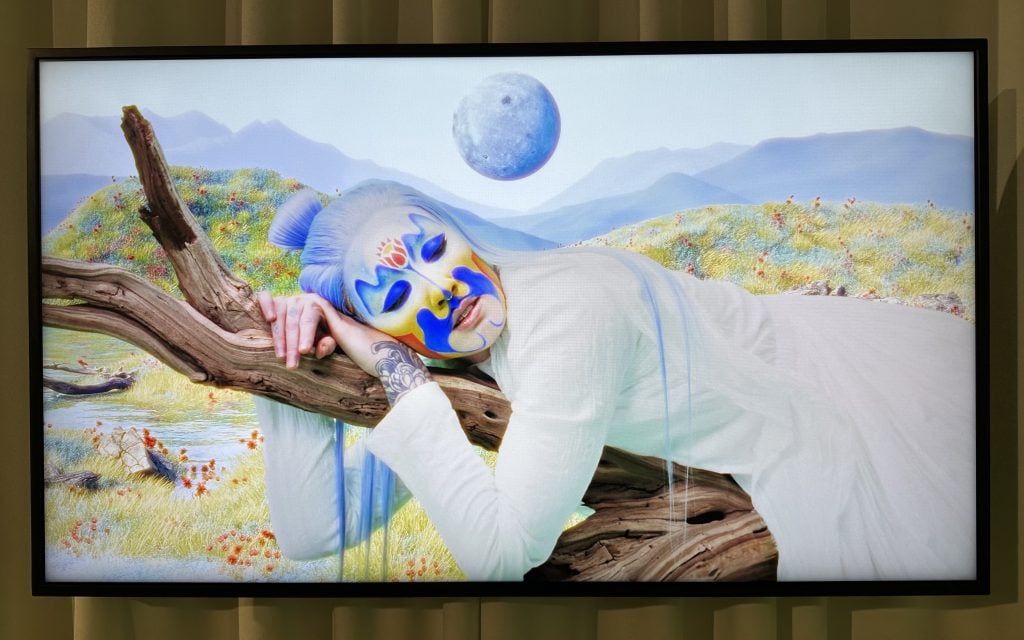
Mutability and doubleness are the hallmarks of Sin Wai Kin’s revelatory work, with the London-based Canadian artist blending drag performance, Cantonese opera, art history, and contemporary screen culture into dreamlike reimaginings of the world. Best known for their narrative films, which garnered the artist a Turner Prize nomination, they have also begun making standalone portraits of recurring characters, and this is the body of work shown by London’s Soft Opening at the fair: looped moving-image tableaux that present these figures re-enacting works by Leonardo da Vinci, Man Ray, Frida Kahlo, and other artists.
In this portrait, the artist inhabits the role of “the Universe” as they recreate Ming Dynasty artist Lu Zhi’s painting Dreaming of a Butterfly, which depicts the story of a man whose vivid dream of a butterfly leaves him uncertain, upon waking, whether he is a human dreaming of being a butterfly or a butterfly dreaming of being a human. In the piece itself ($18,000), the figure lies sleeping on a fallen tree, the flower painted on their face echoing the flowers in the field waving gently in the background. A story of new possibilities is being told here, fluidly melding binaries of past and future, painting and video, East and West, male and female into something that has the ring of prophesy.